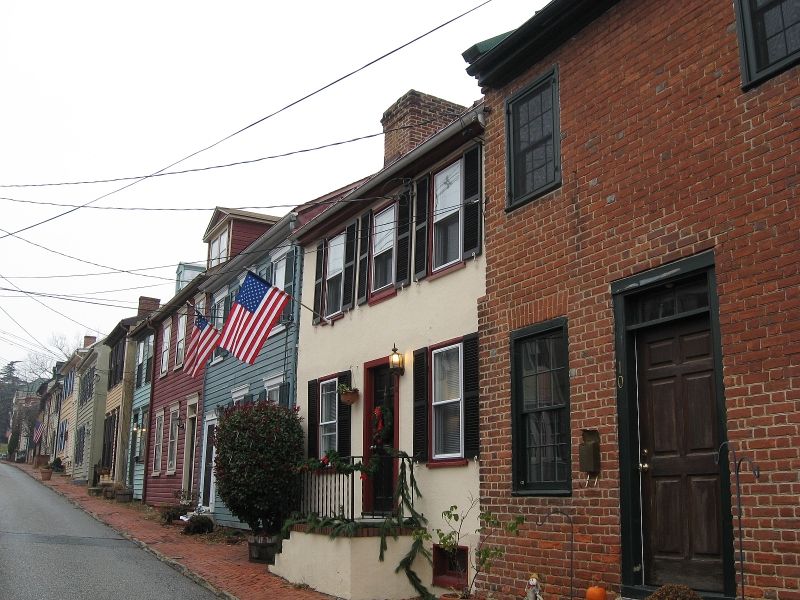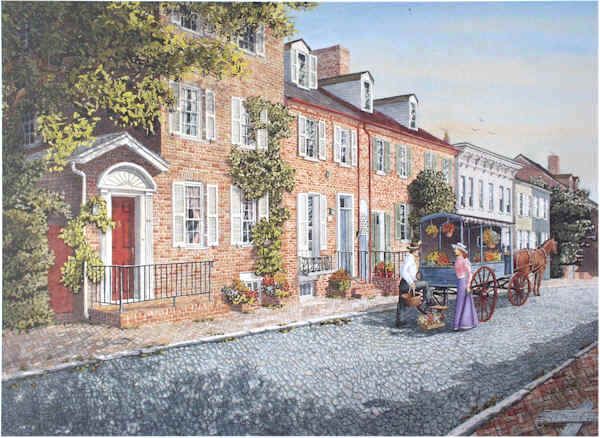Options
Numismatic History – John Chalmers and His Coins
 MidLifeCrisis
Posts: 10,550 ✭✭✭✭✭
MidLifeCrisis
Posts: 10,550 ✭✭✭✭✭
Let me start by saying that I welcome any comments or corrections that noted experts, such as Pistareen, ColonialCoinUnion, and novacaesarea, would like to make. They are far more knowledgeable on this topic than I am.
John Chalmers
Captain John Chalmers, Sr., was a goldsmith and silversmith who achieved prominence in Annapolis, Maryland. Born about 1750 in Annapolis, not much is known about Chalmers’ early life. He served in the Continental Army as a recruiting officer and a supply officer during the Revolutionary War. By 1783, Annapolis tax records show John Chalmers was a successful businessman, financially ranking among the top 20 percent of that city’s citizens.
Also in 1783, Chalmers produced a series of silver coins of his own design. Values were of threepence, sixpence, and shilling. These coins are significant as the first privately and domestically made silver coins to circulate in North America since 1652.
Johann Davis Schoepf, a German who visited America in 1783 and 1784, wrote of his visit to Annapolis and noted that the Chalmers coinage was initiated to prevent some of the abuses then being practiced with fractional parts of the Spanish dollar. It was customary at the time to cut a Spanish silver dollar into halves, quarters, and eighths, with the eighths being known as "one bit" or 12-1/2 cents. Some less than honest folk would attempt to cut five "quarters" or nine or ten "eighths" out of one coin. Schopf reported that Chalmers redeemed various fractional parts and exchanged his own coins for them.
Although the coins had no official status and were privately issued, apparently the government took no exception to them. Most show evidence of considerable use in commerce. The shilling denomination apparently was produced in the largest quantities, for these are most often seen today.
The building in which these pieces were coined stood at Fleet and Cornhill streets in Annapolis. Historians say property records show that Chalmers owned 14 Cornhill St., but many old-time coin collectors believed that he worked a few doors down at 10 Cornhill St., in a small red-brick building with a large chimney. Interestingly, my own research does not specifically corroborate this. Instead, I found a reference to primary source documents which indicate that Chalmers leased property on Cornhill Street in 1779 from Frances Leclew and William Gordon. This reference further indicates that corresponding deed research shows Leclew and Gordon owned land at what is presently 18 Cornhill Street.

Houses on Cornhill Street. The Chalmers House is the brick building on the far right.

Another, perhaps more pleasant view of Cornhill Street in Annapolis.
In 1785 John Chalmers became the first white male to join the Methodist church in Annapolis. In 1786 he sold a lot in the northeastern part of the City, for the sum of 55 shillings, to the trustees of the Methodist church for building a meeting house. He was also appointed to the board of trustees of the first college erected by the Methodist Church in America, Cokesbury College, named for Bishop Coke of England. In 1813 Chalmers was expelled from the Methodist Society for his alleged sexual relations with a female slave.
There is evidence that Chalmers may have eventually fell into debt. In 1789 he mortgaged property which had been inherited from his father and he moved his family to Baltimore sometime after 1791. Records indicate that he opened a ship chandler’s store on Cheapside Street near Baltimore’s dock area, and that in 1796 he and his son became involved in the operation of a rope factory.
John Chalmers died on June 19, 1817, at age 67. He was buried in the “Burial Yard, Methodist Old Town” in Baltimore.
His Coins
The threepence and shilling featured, on the obverse, two birds fighting over a worm while a snake lays waiting behind a hedge to attack them. The reverse side shows a wreath encircling two clasped hands shaking in friendship. The sixpence reverse is similar to the shilling, but a star replaces the hands. The sixpence obverse features a cross design with the legend: "I.C. SIX PENCE 1783." It was designed by fellow silversmith and friend Thomas Sparrow, whose initials appear on the coin.

One variety of the 1783 shilling with rings and stars on the reverse is exceedingly rare, with fewer than a half dozen known. The coin shown above was sold in Stack’s May 2004 sale of the John J. Ford, Jr. Collection, Part II, for $172,500 (all in).


1783 Chalmers Shilling, Short Worm, PCGS Certified XF40, CAC, Ex Stack's October 1984 sale of the Richard Picker Collection, lot #109
The 1783 Chalmers Shilling
- Comes in two varieties: Long Worm and Short Worm. The "worm" is the squiggly, vertical line between the two birds, not the horizontal snake in the upper half of the circle. A quick way to tell the difference between the two varieties is to look at the worm: on the "Long Worm" variety, the worm is heads-up while on the "Short Worm" variety, the worm is upside-down.
- No official authorization exists for the coinage, but no law existed which would have prevented Capt. John Chalmers from making these coins, as long as they were of honest weight and fineness.
- Walter Breen and others suggest that the worm being fought over by the two birds is really a snake, noting that the so called worm has a head which is much larger than the body, as seen in the snake above and outside the fence above the birds. Further, a worm would be proportionately much smaller than depicted.
- Breen also interpreted the scene portrayed on the obverse as "While you states go on squabbling over trivialities [boundary disputes?], you don't notice what is coming over to devour you", referring to the larger snake above. He goes on to say that this is a warning that a strong centralized government (the large snake) might well destroy the hard-won status of individual states as independent sovereign entities under the Confederation.
- Breen speculated that Chalmers was attempting to secure a coinage contract with the Continental Congress, which met in Annapolis from November of 1783 through August of 1784.
- Perhaps these were more for advertising the family business rather than a coinage for profit motive. However, researchers have suggested that Chalmers made a reasonable profit from his enterprise. He alloyed the silver to copper, producing shillings of about 81% to 86% silver at an average weight of fifty-four grains which, earned him about an 8% profit.
A Threepence is Found
In the fall of 2003, Will Mumford, a retired economics professor, discovered a Chalmers threepence coin in dirt excavated from an 18th century home at 10 Cornhill Street in Annapolis, MD. The home had never been excavated before then.
"It was a one-man dig, and if I hadn't volunteered, all the excavated dirt would have gone to the dump. I dug for three weeks and discovered a brick floor about a foot below the surface. Below the bricks, I found about five inches of pure sand, then a mixture of sand and soil. Another six inches down, I hit clay bottom. In this bottom layer, I started finding artifacts of the 18th century."
On Oct. 16, Mumford was sifting through some dirt in his driveway when he found a small object. At first he thought it was a button. But when he washed it off, he said, he realized "there was no hole in it."
When he put the coin under a magnifying glass, he noticed the inscriptions: "Annaps." and "I. Chalmers." During that time, most printing presses and dies used "I" instead of "J."
Mumford found 22 coins in all, including a Connecticut Cent, a Virginia Halfpenny, and a William III halfpenny.
For Mumford, "It has been the time of my life. At age 70, it has been my greatest adventure."
Sources:
1. John Chalmers, Issuer of the Annapolis Coinage, by Wm. F. Perlitz. The Numismatist, Nov 1948.
2. The Life and Coins of John Chalmers, by Henry W. Schab. The Numismatist, Nov 1984.
3. A Guide Book of United States Coins, by R S Yeoman, 42nd Revised Ed, 1988.
4. Website: http://socialhistory101.info/2010/02/04/capt-john-chalmers-sr/
5. Website: www.coinfacts.com
6. Website: www.icollector.com
7. Website: www.coinbooks.org/esylum_v06n51a05.html
8. Website: www.pcgscoinguide.com
9. Threepence the richer, by Jason Song, The Baltimore Sun, November 13, 2003, website: http://articles.baltimoresun.com/2003-11-13/news/0311130405_1_mumford-chalmers-coins
10. Website: www.msa.md.gov
11. Catalog of Stack’s May 2004 sale of the John J. Ford, Jr. Collection, Part II.
12. Website: http://www.coins.nd.edu/ColCoin/ColCoinIntros/Chalmers.intro.html
0
Comments
Jim
When a man who is honestly mistaken hears the truth, he will either quit being mistaken or cease to be honest....Abraham Lincoln
Patriotism is supporting your country all the time, and your government when it deserves it.....Mark Twain
shilling in name only. By law in Maryland there were 7 shillings 6 pence to the Spanish dollar, which meant an
effective value of about 13.3 cents for the Maryland shilling. For practical purposes the Spanish silver one real
was considered equivalent to the Maryland shilling which means that the true denomination for the Chalmers
shilling was the Chalmers one real. His sixpence and threepence were equivalent to the half and quarter real
coins struck by Spain in the American mints.
Here are two more that I handled in the last year.
<< <i>This is a great thread.
I agree. Thanks for taking the time.
This is why I keep checking in here.
<< <i>NewEnglandRarities - those are some nice looking pieces! Can you tell us any more about them? >>
Hey MLC,
Both pieces were purchased privately in the last year. The first one was a couple I handled a few years back, repurchased and sold again. I did not find it listed in any recent auction sale but I should look at some older auctions to see if it is listed. It graded XF45 PCGS
The second one was purchased at the Philadelphia show last year. It was purchased out of a Stacks sale in the mid 80s though I have not been able to find the exact sale it came out of yet. I purchased it from the collector who bought it out of that auction, but he could not recall the exact sale. It was in an NGC AU53 holder, though the new owner is a raw collector so it was cracked out.
I would think with a bit of looking, these pieces could be found with a good pedigree attached and just lost over the past 10+ years.
I knew it would happen.
Lance.
I read recently that Annapolis was the most refined and genteel of New World townships in this era (can't remember if it was Mossman or Nipper I was reading)
www.brunkauctions.com
Denga: <<For practical purposes the Spanish silver one real was considered equivalent to the Maryland shilling which means that the true denomination for the Chalmers shilling was the Chalmers one real. His sixpence and threepence were equivalent to the half and quarter real coins struck by Spain in the American mints. >>
This is very interesting and certainly a point of historical importance. In my current article, I referred to the Chalmers pieces as being of British denominations. Perhaps I should have qualified my statement.
In any event, there is an extremely important group of Chalmers pieces in an auction this week. I feel fortunate to have had the opportunity to view them already and to write about them.
Major Collection of Colonials To Be Auctioned
siliconvalleycoins.com
RMR: 'Wer, wenn ich schriee, hörte mich denn aus der Engel Ordnungen?'
CJ: 'No one!' [Ain't no angels in the coin biz]